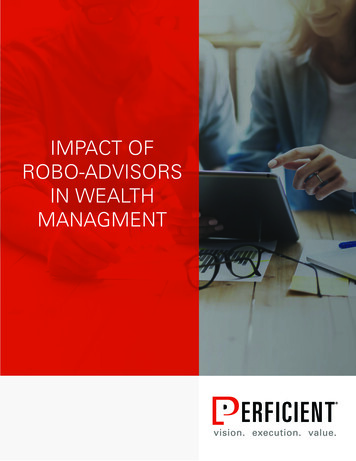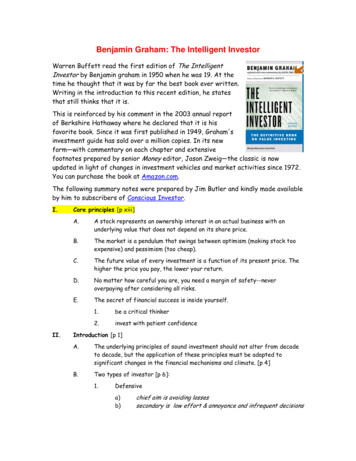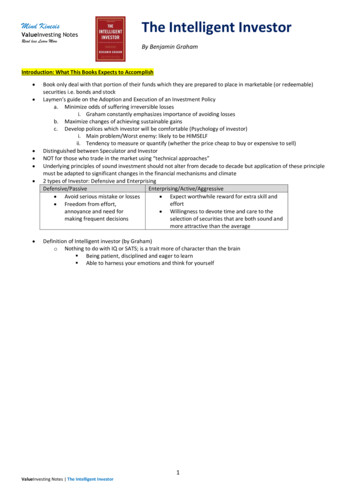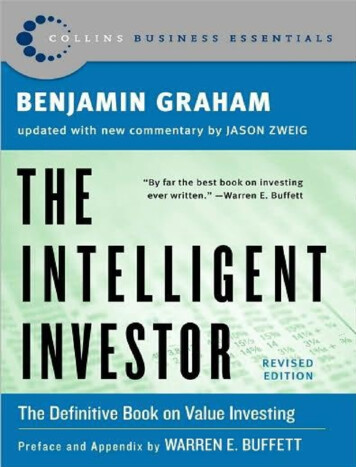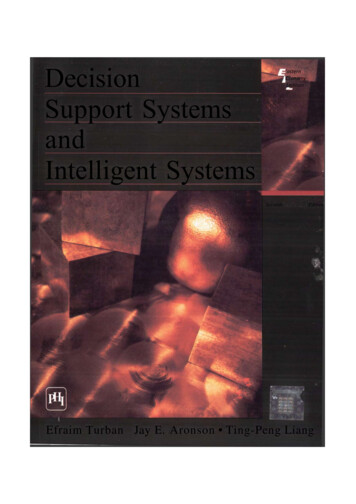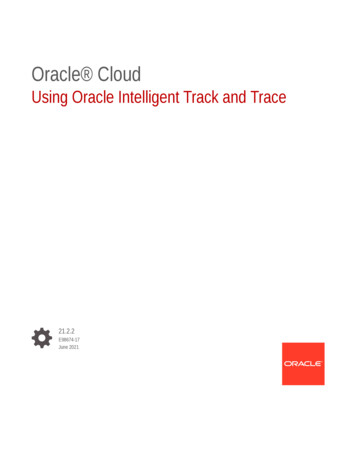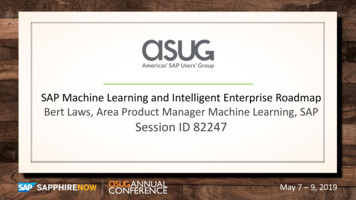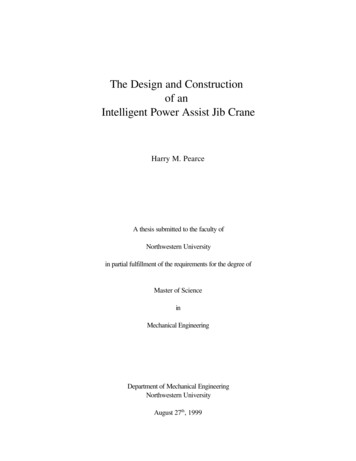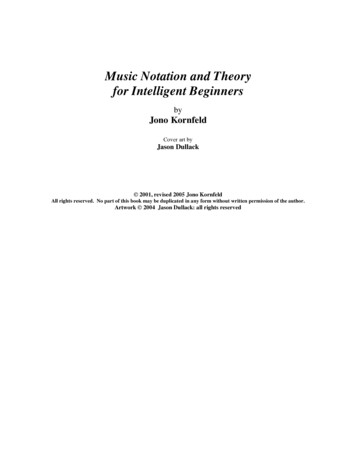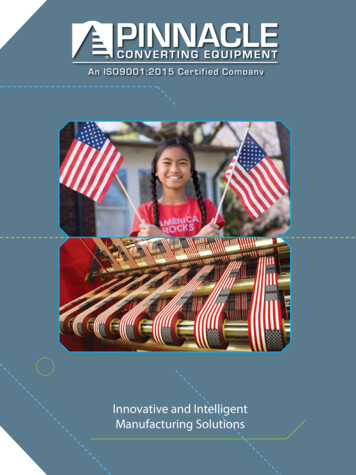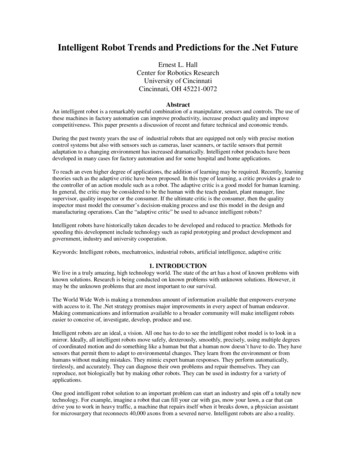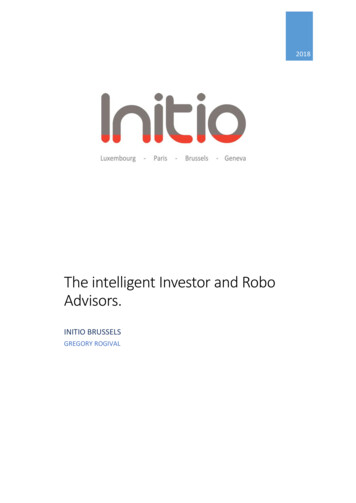
Transcription
2018The intelligent Investor and RoboAdvisors.INITIO BRUSSELSGREGORY ROGIVAL
SummaryThe intelligent Investor and Robo Advisors. . 2The Intelligent investor: . 2Financial biases: . 3Robo Advisors and Artificial Intelligence (AI). 6About Initio . 9Author & Contact . 9
The intelligent Investor and Robo Advisors.When writing this article, I thought at first that the title looked too much like a “Fable de LaFontaine” such as “Le Corbeau et le Renard”.Robo advisors and to some extent Artificial Intelligence (AI) are today at the heart of vast discussionsand may create a lot of opportunities but also threats. The use of robo-advisors and AI is also astrategic decision for many companies in virtually every sector. Artificial Intelligence is presenteverywhere: in medicine, law and the financial sector, in particular in banking and insurance.But what about approaching the problem differently and like Simon Sinek1 did in his book “Start withwhy”; we can start this article by asking "why"? Why should investors use Robo advisors in theirfinancial decisions? Below are issues that we will discuss in this article:The Intelligent Investor2: An intelligent investor is a paradigm of investor. In his book BenjaminGraham defines who the intelligent investor is and we will highlight some of the key elements.The investor and his biases: it is true that when speaking about investment, we all want to be seenas “Intelligent Investors”. However, only happy few will be similar to Warren Buffet. We are humanbeings and have emotions. Our emotions are biases and some even say that for investments weoften are our worst enemies. We will have a look at these biases in general and focus a bit more themain ones.The value proposition of Robo advisors: this part will be the core of this article. Why this would be anadvantage for the investor in portfolio allocation? When we know the why, it is easier to understandthe value proposition and what already exists on the market.The last part will focus on the investor again with the question: Is the investor ready?The Intelligent investor:Let’s start with a question. According to you, who may be considered as an intelligent investor?1. Warren Buffet2. Isaac Newton3. Irving FischerThe answer is Warren Buffet but the point is that finance has its own definition of “intelligence”.Isaac Newton was a great mathematician and made a terrible loss with the South Sea companyshares. He mentioned he “could calculate the motions of the heavenly bodies, but not the madnessof the people” (and in a way he stated some arguments for behavioural finance with the madness ofpeople).Irving Fischer was an economist. He wrote “The theory of interest” and was widely listened to. Onthe eve of October 1929 he wrote that stocks have reached a “permanent” high plateau. The crashhad several consequences, he lost his fortune and his reputation.12Simon Sinek; “Start with Why”; Portfolio Penguin; 2009Benjamin Graham; ”The intelligent investor”; Harper Business;1984 (revised edition 1971, 1972)
The Intelligent investor is a book written by Benjamin Graham. Some say he is the financial teacherof Warren Buffet. In his book he presents his vision of the Investor and makes recommendations forthe safe or dynamic investor. One remark in his book is that the Intelligent Investor sells shares tothe optimist investor and buys from the pessimist investor.There are many books about investing. Those are generally written by people who made succeededfinancially. For example: The little book that beats the market3 or the Motley Fool. These writerspropose their own recipes. Some use fundamentals, ratios and long term perspective such as valueinvesting. Others prefer a short term vision and technical analysis with the ambition to realize rapidgains. However, all of them apply a recipe and we know in order to enjoy a good meal we have tofollow the different steps in their preparation. And with the steps we introduce the logic ofalgorithm. Then why is it so difficult to be an intelligent investor when we only have to follow arecipe? Because in terms of “financial investment”: We are our worst enemyWe pretend to be rational but we are notThere is a lack of financial knowledge (does all investors know the financial ratio?)We face Mr Market (the aggregate of all investors) who can be at moment a really goodfriend and at other times a real foe.Financial biases:The majority of the investors have trouble with financial decisions for their own portfolio. Commonsense says: buy low and sell high. Then why does the majority of investors sell low and buy high?The purpose of this article is not to go into the details of behavioural finance but just to mentionthem and focus our attention to one specific bias.If we were a Homo Economicus and rational there would not be a place for behavioural finance andeconomics. We have to admit that in addition to rationality humans have emotions and this causesproblems or distortion in the decision process. In his book “Thinking fast and slow” Kahnemann(Nobel Prize of economics and psychologist) speaks about two ways in which information can betreated: the fast way based on emotions and the slow one based on reason. James Montier whowrote on behavioural investing gives a description of the two main characters of Star Trek: CaptainKirk (the emotion based decision- automatic and effortless) and doctor Spok (the rational decisionbased- logical a deductive).3Joel Greeblatt; “The little book that beats the Market”; Willey 2010
Beside the fact that he uses those two characters to describe the emotion system and the reasoningsystem, he gives a good definition of them4:System One/ X-system/ Reflexive/ Intuitive(fast)HolisticAffective (what feels good)Associative- judgements based on similarity andtemporal contiguityRapide parallel processingConcrete imagesSlower to changeCrudely differentiated – broad generalizationCrudely integrated- Context specific processingAutomatic and effortlessSelf-evidently valid: “Experiencing is believing”or perhaps wishing is believingOur biases:System Two/ C-system/ Reflective (slow)AnalyticLogicalDeductiveSlow, serial processingAbstract imagesChanges with speed of thoughtsMost highly differentiatedMost highly integrated – Cross contentprocessingExperienced actively and consciouslyControlled and effortfulRequires justification via logic and evidence.First, let’s have a look at the different biases stated in behavioural finance and a more friendly wayto state the bias. Then we will focus on the prospect theory.Our bias – The academic point of viewProspect theoryOverconfidenceCognitive dissidenceMental CompartmentsAttention anomaliesAnchoringRepresentativeness heuristicDisjunction effectMagical thinkingCultureAntisocial personality disorderOur bias: a common sense approachI know better because I know moreI’m better at investing than the averageShow me what I want to seeHeads was skill, tails was bad luckI knew it all alongI can make a judgement based on what its look likeThat’s not the way I remember itIf you tell me it is so, it must be trueA loss isn’t a loss until I take it.4James Montier;”Behavioural Investing”; Willey 2007
The prospect theory or risk aversion theory explains why most of the investors do not behaverationally but emotionally. It explains why we often buy high and sell low instead of the commonsense approach: buy low sell high.Prospect theory was developed by Daniel Kahneman and Amos Tversky (now both are Nobel Prizewinners of economy and both psychologists). The theory is based on the utility theory, which can besummarised as follows: the more utility you have, the more satisfaction you have on a bargain. Onthe other hand, a negative utility means dissatisfaction and/ or frustration.Let’s look at the prospect theory with a graphic5:And now let’s take the time to gamble.“You are offered a gamble on the toss of a coin. If the coin shows tails, you lose 100 . If the tossshows heads you win 150 . Is this gamble attractive? Would you accept it?The expected value of the gamble is positive (50% chance to win 150 and 50% chance to lose 100 .However and based from the graphic above, people (investors included) give more weight or impacton the losses.In the example: the have a negative utility (-3) at the idea of losing 100 and only a positive utility(1.5) when speaking about 100 gains.This bias is clear enough to say that for the majority of the investors it is difficult to behave with arational mind-set as we already have an asymmetric perception of gains and losses.5Daniel Kahneman; “Thinking fast and slow”; page 283,FSG 2011
Robo Advisors and Artificial Intelligence (AI)The question is then: “Are Robo Advisors useful for the investor?” or, what the value proposition ofthem is.Before that we start with the value proposition, we have to understand what we mean by roboticsand AI.According to HBR review, there are three big mainstreams in robotics and Artificial Intelligence:Process automation, cognitive insight and cognitive engagement. Those mainstreams start from theeasiest to implement (Process automation) with a light cost of implementation to the more complexapproach (cognitive engagement) involving a high cost and complex implementation projects.Process Automation or Robotic Process Automation (RPA ): the robot acts like a human doingoperational work and processing or using IT information from different sources.For example:transferring data from e-mail and call center systems into systems of record—for example, updatingcustomer files with address changes or service additions;Robots with cognitive insight detect patterns in vast volumes of data and interpret their meaning. Itcan for instance predict what a particular customer is likely to buy using machine learning and deeplearning.The last approach is cognitive engagement and represents the most complex use of AI capable ofinter-acting with the customer, and, based on the acquired knowledge, proceed torecommendations. Here, an example would be: product and service recommendation systems forretailers that increase personalization, engagement, and sale.An example of Belgian Financial Fintech is Gambit Financial Solution with its 2 solutions Squirree andBirdee.The mission of this Fintech is: We can create a unique clients’ experience in the financial industry,build portfolios, follow them day to day, automate rebalancing, and provide the info online.The value proposition is simple and clear. Depending on the channel you want to invest, digital orbranch assisted, Gambit Financial Solution can provide a tool based on behavioural finance and analgorithm to help you manage your investment. If your objective is to build and manage a portfolio100% online then Birdee (also present within Keytrade bank) is for you. On the other hand, if youwant a tailor made service or advice in the branch or private banking then Squiree is the platform isthere to help you.
SquireeBirdee Focus on the value created in the advisorclient interactionStand-alone product Off-line and on-line Advisory, discretionary and execution only Covers fiscal envelopes Fully Modular Includes a complete client journey(Internet and mobile) from on-boarding toreporting Connects to clients data for contextualhelp and advicesSquiree (Gambit financial solution core business: financial advisor investment tool toprovide efficient advices to the customer – mass retail, wealth segment and private).Efficient tool for financialplanningAdvanced portfoliomanagement for gapanalysis and rebalancingAutomated process (foronline model) or semiautomated process (brickand mortar)Perform portfolio checksand reportingRisk profiling toolInvestmentrecommendations basedon portfolio, risk profileand preferences ofinvestments
Birdee (new target – full online customer who wants to invest and is not a financespecialist).100% onlineonboarding (Mifidand KYC)Alerts and newsfeedOnline portfoliomonitoring andgoals managementCommunicationplatformAdvice validationand themeportfolios ( Europe,Biotech.)Dashboard 360 management oncomputer anddevicesIn September, BNP Paribas AM took a major participation in Gambit Financial Solution. Thepartnership with BNP AM has the objective to give an edge in the robot-advisory solution marketand this for mass retail banking and private banking.This is one example. There are more examples on the market. Some other fintechs focus on theinvestment profile and behavioural finance, such as Neuroprofiler while other big names, such asVanguard, build their own robots.If as investors, we accept the fact that we make investment mistakes because of our behaviourAIand algorithm value proposition may be a solution by offering to us a rational perspective on ourinvestment and portfolio management. An algorithm based on theoretical finance may help us toachieve our objective with a better control of the risk/ return principle. This does not mean that AI isthe solution to avoid or completely erase the risk factor. Humans make mistakes but we have toremember that machines too, although in a low proportion. However, we are more indulgent aboutour own mistakes than machine mistakes, in other words we more easily forgive ourselves but notthe machines.We mentioned at the beginning Star Trek Captain Kirk and
The Intelligent Investor2: An intelligent investor is a paradigm of investor. In his book Benjamin Graham defines who the intelligent investor is and we will highlight some of the key elements. The investor and his biases: it is true that when speaking about investment, we all want to be seen as “Intelligent Investors”. However, only happy .
